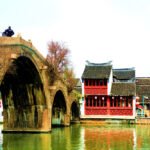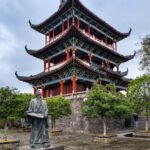Xiaosha Tourism Area is located in Xiaosha Town, Dinghai District, Zhoushan City. Rich in cultural relics and historical landscapes, Xiaosha Town is home to numerous cultural heritage sites, including the Fuweng Hall, which is listed as a cultural heritage site in Zhoushan City, and the Sanmao Ancestral Home, Shuailong Bridge, and Tianhou Palace, which are protected by Dinghai District. There are also the Buddhist sacred site, Qingjing Lecture Temple, the ancient nunnery, Jingtu Temple, and the Xiaosha National Culture Activity Center, which features ancient cultural architecture. The ancient stone bridge, Siling Ancient Bridge, situated in a secluded valley, adds to the unique cultural atmosphere of Xiaosha, making it highly valuable for tourism development.
Sanmao Ancestral Home: The ancestral home of Sanmao was built by her grandfather, Mr. Chen Zongxu, in the last century and is located in Chen Family, Xiaosha Town.

Fuweng Hall: Nestled in the green hills of Wangjia Village, Fuweng Hall was first established in the 24th year of the Hongwu Emperor’s reign during the Ming Dynasty, with a history of over six hundred years. According to county records, in the early years of Hongwu, Emperor Zhu Yuanzhang ordered the relocation of residents from forty-six islands of Changguo (present-day Zhoushan) following a memorial from minister Tang He. The unwilling residents scattered and hid, leading to a period of displacement and fear. The commoner Wang Guozuo, unable to bear the suffering of the people, endured hardships and personally petitioned the emperor, arguing against the relocation. As a result, more than eight thousand people of Changguo were able to live and work in peace. The people were grateful to Wang Guozuo and called him ‘Mr. Fuweng,’ and his residence became known as ‘Fuweng Hall.’






